Today is the start of a series dedicated to growing the photographer in you. It will start with the basics and will slowly advance toward more complex and creative aspects of photography. I am going to put these lessons together one by one in the order that they should be learned. So welcome budding photographer!
If you have always enjoyed photography, but have never been completely satisfied with the results, this is for you. Composition is the biggest defining factor of what turns a snapshot into artwork. You don't need an expensive camera or lighting, what you need is composition. Artwork has been made with pinhole cameras, cruddy Holgas, and even phones.
So what is composition? There are a lot of so called "rules" to composition, but for every piece of art that follows the rules, there is one that breaks them too. One of the more popular rules is the rule of 3rds. This states that if you break your picture up into three sections vertically and three sections horizontally that you should put the focus of your picture on one of the lines that separate the thirds. This does work to help make a lot of shots much better than they could have been if it wasn't followed, but one of the reasons it works is it makes you make a decision. It makes you decide what is it that is interesting, and that is really what you should be thinking of. This picture of the Space Needle shows the rule of thirds in action, the Space Needle itself is on one third line while the tree in the foreground is in another. I didn't even think of the rule of thirds when taking this shot, I only thought of the composition, but it does show how that tool can be used to help as you start out. Just remember not to be a slave to the rule, don't force it on all of your subjects if you don't think it works for it.
 |
Camera: Nikon D80
Lens: Nikon 24-120mm f/3.5-5.6 AF-D
Focal Length: 28mm
Shutter: 1/6
Aperture: f/3.8
ISO: 1600
Flash: None |
Think of this instead, when you go to take a photo what made you decide to take that photo, why are you there? If you can decide why you wanted to shoot this particular subject in the first place, then you can compose an image around it. Once you have decided what you want to shoot and why you want to shoot it, look at what potential distractions there are in and around your subject. There may be too many to get that shot you really want, so what alternatives are there. For instance, I love shooting vintage cars and motorcycles, and sometimes I happen upon them in parking lots. I always feel lucky for the find, but then realization sets in, a parking lot (or car show for that matter) is the absolute worst place to shoot. Why is that? There are always too many distractions to get a clean shot of the full vehicle that you probably wanted. Don't fret though, there are probably plenty of pictures of that same exact make and model vehicle, or whatever it is, everywhere. What makes the one you are looking at unique? Is there anything you can do different? Once you know what it is, GET CLOSE. When you are trying to separate something out and make it the focus there is no replacement for getting close. Resist the urge to zoom in, zoom in with your feet.
So lets look at some examples of getting close to get the shot. First we will start with this old Packard. This car is just so interesting to me. No real damage to be seen, but it has been withering away in the elements for a long time. It is just a cool old car, but, in every angle there are ugly power lines, the tops of other buildings, no real way to get a clean shot of it. Here is your typical 20 foot snapshot that most tourists would take of the car. It will bring back the memory, but you probably aren't going to hang it on your wall.
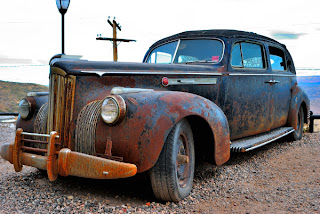 |
Camera: Nikon D80
Lens: Nikon 24-50mm f/3.3-4.5 AF-D
Focal Length: 24mm
Shutter: 1/100
Aperture: f/5
ISO: 100
Flash: None |
Now when I really ask myself, what draws me to this car, it's the patina. The rusting showing through the paint with that orange hue on otherwise undamaged bodywork. It just shows how long that it has been here. The fact that it sits in front of a haunted hotel all the better. So I decided that since the patina attracted me, that is what I want to see. I focused on several areas around bits that were interesting. Badges, lights, etc... obviously not just the side of the door. After getting several shots I found what I was looking for. Working within mere inches of the car with a 24mm lens (on DX so 36mm equivalent) I produced this shot.
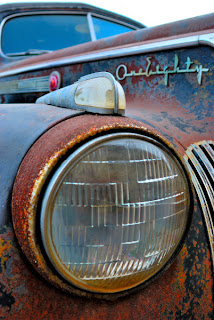 |
Camera: Nikon D80
Lens: Nikon 24-50mm f/3.3-4.5 AF-D
Focal Length: 24mm
Shutter: 1/100
Aperture: f/5
ISO: 100
Flash: None |
I think you'll agree that by finding a piece that is interesting and different that I was able to produce a piece of artwork from a subject that would have otherwise been just a nice family trip snapshot.
This second set of examples is a motorcycle in my daughter's school parking lot. I really liked the look of this bike. It looks like a well ridden restored classic (when in actuality it is a well ridden 2003 model) that is really quite tough to find nowadays where every classic bike is either a restored show piece or really rough in dire need of a restore. It is hard to find the look of an enjoyed every day but not ultra clean cycle, so I really wanted to get some shots of it. The problem is it is in a school parking lot, worse yet it is parked next to a white truck that I can see from any angle shot from the left, and reflects in the fuel tank really well shot from the right. Oh, and a modern scooter is in the spot with it. Ugh. This is the snapshot that I took at the start.
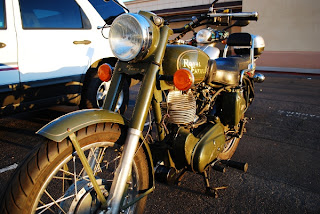 |
Camera: Nikon D80
Lens: Nikon 18-55mm f/3.5-5.6G VR
Focal Length: 18mm
Shutter: 1/60
Aperture: f/4
ISO: 100
Flash: None |
So what is interesting about this bike. Well, the tank is well worn while otherwise undamaged, so I like that. There is a bodge job fix to the external oiling system on the right side of the engine, and the dirty carburetor is on the right side of the engine as well. But, probably the best item that is happening at the time of my shot is the sunset. Now be careful, looking at the sun through your viewfinder is a very very bad idea. Be very careful, I kinda work with my eye away from the viewfinder and scan around inside to frame my shot, but it means I will be making a few shots to get it just right. In this case I wanted to have the sun cresting the tank just at the leading edge of the fuel cap. As you can see from the shot, I think it worked. There are still some distracting light poles and stuff in there, but I feel the rest of the shot overshadows the flaws enough that I have included it in my collection.
 |
Camera: Nikon D80
Lens: Nikon 18-55mm f/3.5-5.6G VR
Focal Length: 18mm
Shutter: 1/60
Aperture: f/6.3
ISO: 100
Flash: None |
Now that we've talked about getting close lets talk about GETTING LOW. Changing the perspective can add interest to otherwise mundane everyday items. We see our entire life from eye level, change your perspective. The best thing about getting low is you don't need anything to do it, just a willingness to lay on the ground. Some of my best shots have been made squatting or laying on the ground. Take this shot for instance, one of my absolute favorites (and is my mom's favorite). This is a set of plain sheet metal mailboxes. Who cares, right? What is holding them up is a Singer sewing machine treadle covered in vines. Now I could have shot them at eye level or at mailbox level and would have a nice shot to remind me of it. But anyone else viewing wouldn't notice. They'd walk by and wonder why I shot that and then hung it on a wall. The treadle had to be the focus, so I laid in front of it and shot one of my favorite pieces. Not only does it make the treadle stand out more, the perspective throws the casual viewer off kilter and makes them think, what did he do here. A wide lens again makes sure that my close personal proximity to the subject brings it to the forefront of my shot.
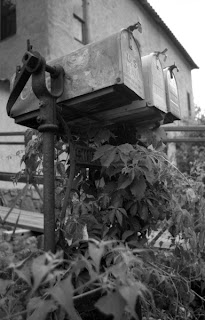 |
Camera: Nikon F4
Lens: Nikon 24mm f/2.8 AF-D
Focal Length: 24mm
Shutter: N/A
Aperture: N/A
ISO: Ilford Delta 100
Flash: None |
DON'T TRY TO COPY someone else. The best way to make nothing is to try and copy someone else's style. You are the artist, something drew you there, what is it. My best example would be my fiance. We were hiking in Sedona and I was carrying my camera as always, shooting items that jumped out at me as interesting. As the sun was going down she told me to "shoot that". I gave her the camera and she resisted at first, but as I told her, she is the one seeing the interest in the shot and she knows what she wants in her minds eye. She went on to shoot what she saw, and I really like it. She saw something I hadn't at the time, and she captured her vision.
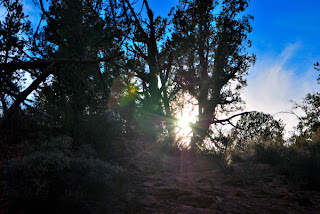 |
Camera: Nikon D80
Lens: Nikon 24-50mm f/3.3-4.5 AF-D
Focal Length: 18mm
Shutter: 1/400
Aperture: f/10
ISO: 100
Flash: None
Photo Courtesy of Karla Sapien |
DON'T RELY ON ZOOM to make your frame. Zoom lenses really spoil us. The problem is that sometimes they make us lazy and uninteresting too. I occasionally go out with nothing but a prime lens to reacquaint myself with the need to move to get the shot I want. It is way too easy to just stand there and rotate the zoom ring until the framing is proper, there is a place for it but if you find you are always zooming to frame you may be cheating yourself out of better shots. Sometimes it is needed, and when you are trying to match two greatly different sized objects (like a mountain behind people) they can be a godsend, but remember that your feet work too.
In the end make sure you are being true to yourself and your vision, that is what makes you unique. Show others how you see the world and what in this world interests you, there is a following out there for everything, even if what you find interesting is shooting the hands on clocks. And if someone hates your work that is ok, good art should evoke dramatic feelings, and dramatic feelings will always leave people either loving or hating your work. One of the (ahem) great things about the internet is that you are sure to hear about it when somebody hates your work. And lastly never lose sight of the fact that photography should always be fun, if you aren't having fun then you're doing it wrong.
Thanks for reading.








No comments:
Post a Comment